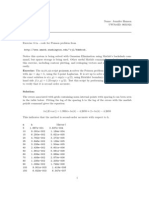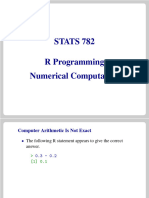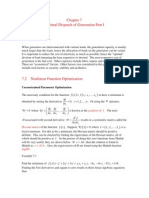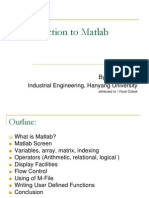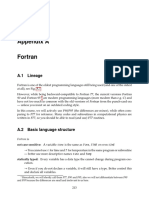Cmdie
Cmdie
Uploaded by
Beny AbdouCopyright:
Available Formats
Cmdie
Cmdie
Uploaded by
Beny AbdouOriginal Title
Copyright
Available Formats
Share this document
Did you find this document useful?
Is this content inappropriate?
Copyright:
Available Formats
Cmdie
Cmdie
Uploaded by
Beny AbdouCopyright:
Available Formats
CMDIE WS2002/03
8. Mai 2003
Finding an Eigenvector and Eigenvalue, with Newtons Method for Solving Systems of Nonlinear Equations
Report
Harald R ck o
hroeck@cosy.sbg.ac.at
Academic Supervisor Prof. Roman Trobec
Department of Scientic Computing University of Salzburg
Project in CMDIE WS 2002/03
Introduction
Let A be an n n Matrix, we wish to nd a nonzero vector x and a scalar such that Ax = x Such a scalar is called Eigenvalue, and x is a corresponding eigenvector. Newtons method for solving systems of nonlinear equations is a xed point iteration algorithm for nding roots of a function. A root of a function f : Rm Rn is a vector x Rm such that f (x) = O. Such a root is not unique, for Newtons method it depends on the initial seed wich root will be found. Newtons method is based on the truncated Taylor series of a differentiable function f : Rn Rn : f (x + h) f (x) + J f (x) h where J f (x) is the Jacobian matrix of f , {J f (x)}i j =
fi (x) x j .
If J f (x) h = f (x), then f (x + h) is taken as an approximate zero, and x + h is an approximation of a root of this function. That follows we have replaced the system of nonlinear equation with a system of linear equations which have to be solved at each iteration step.
1.1
Alghorithm
Algorithm [Newtons Method]: x0 = initial guess for k = 0, 1, 2, . . . calculate J f (xk ) and f (xk ) solve J f (xk )hk = f (xk ) for hk xk+1 = xk + hk
end
Harald R ck o
Eigenvalue Problems
Project in CMDIE WS 2002/03
Solution
How can we use this algorithm to calculate an eigenvalue and a corresponding eigenvector x of a n n Matrix A? a1,1 a1,2 a1,n x1 x2 a2,1 a2,2 a2,n A := . . . x := . ... . . . . . . . . an,1 an,2 an,n xn
2.1
A New Function
We dene the function f : Rn+1 Rn+1 f (x, ) = Ax x xT x 1 ; x Rn and R
We see f (x, ) = O if and only if Ax = x and xT x = 1. This is only satised if x is a normilized eigenvector and its corresponding eigenvalue. To use Newtons Method we need the Jacobian Matrix J f of f . We devise Jacobian Matrix as follows: If we write f as an vector we get a1,1 x1 + a2,1 x2 + + a1,n xn x1 f1 a2,1 x1 + a2,2 x2 + + a2,n xn x2 f2 . . . . . =: . . . . . . f (x, ) = . . . . . . . an,1 xn + an,1 x2 + + an,n xn xn fn 2 2 2 fn+1 x1 + x2 + + xn 1 The Jacobian matrix is dened as f1 f1 f1 x2 x1 . . . . . . J f (x, ) := . . . fn+1 fn+1 fn+1 x1 x2 = J f (x, ) = the
a1,1 a1,2 a2,1 a2,2 . . . . . . 2x1 2x2
x1 x2 . .. . . . 0
A I n x 2xT 0
Harald R ck o
Eigenvalue Problems
Project in CMDIE WS 2002/03
2.2
Iteration
Now we should have all what we need for the Newton iteration. In the kth iteration step we have to solve the system of linear equations for [hk k ]T : A I n xk T 2xk 0 hk k = Axk k xk T xk xk 1
and update the current approximation with: xk+1 k+1 = xk k + hk k
At this point we have to talk about a stopping criteria and the initial guess for the iteration. For my implementation I used only a simple check of the size of the updating vector [hk k ]T as stopping criteria. The algorithm will stop if ||[hk k ]T ||inf < , and can be dened by the user, if not it will be = 0.001. It will also stop if a maxima of iteration steps are reached. The standard value for this parameter is 100, but it can be changed by the user. To start our iteration we need an initial guess for x0 and 0 . For x0 we use a random T vector and normalize it, and for we use = x0 Ax0
Results
Followed you nd some testing results 2.9766 0.3945 0.4198 1.1159 0.3945 2.7328 0.3097 0.1129 A= 0.4198 0.3097 2.5675 0.6079 = 4 , x = 1.1159 0.1129 0.6079 1.7231 4 0.5 0 0.1498 5 0.6 = 3.1357 , x = 0.2589 A = 0.6 0 0.5 3 0.9542 0.7606 0.1850 0.3890 0.4858
I also tested the program with some random matrices of size 100100 and 1000 1000 and compared the results with the build in function of Matlab(eig). The result of the function my_eig is most times the biggest real eigenvalue. Harald R ck o Eigenvalue Problems
Project in CMDIE WS 2002/03
7
40
35
30
25
4
20
3
15
2
10
100
200
300
400
500
600
700
800
900
1000
200
400
600
800
1000
1200
1400
1600
1800
2000
Abbildung 1: The graphs are showing the time used to calculate eigenvalues/eigenvectors for increasing matrix dimensions
Complexity
The complexity of this algorithm depends on the used algorithm for the solution of the linear equations. The Matlab proler found the same part of the code. For small matrices the proler detected the calculation of the different matrices as most expensive, but for larger systems its only the part where the linear equations are solved. I did some timing messurements and compared the results with the build-in function of Matlab. The build-in function eig calculates all real and complex eigenvalues of a matrix. This function is surely implemented very efcient and uses an algorithm wich depends on the input matrix. That means it uses implicit a different algorithm for different matrices. Matlab internaly uses Lapack routines to compute eigenvalues and eigenvectors. The method my_eig is only implemented in Matlab script language and not in binary form as the algorithm used by Matlab. It calculates only one eigenvector and eigenvalue, and this is always a real eigenvalue. If the matrix has no real eigenvalue the output isnt correct. i.e. the maximal count of iterations will be reached and it outputs a warning that the result may not be correct. Therefore the function eig is faster although it calculates all eigenvectors and eigenvalues. But for big matrices, i.e. matrices with more elements then 100100, my implementation will be faster most times. At gure 1 you can nd the results of my timing messurements. The y-axe is the time in seconds and on the x-axe you nd the matrix size. The biggest matrix was of size 2000 2000. I tested some bigger matrices but matlab runs out of memory Harald R ck o Eigenvalue Problems
Project in CMDIE WS 2002/03 after a few minutes.
Comments
The method for calculating one eigenvector/eigenvalue pair described above is just one way do nd such a pair. This method nds also only one pair, and this only of the real space. But sometimes eigenvalues/eigenvectors are of the complex number space. Its not easy to nd out whetever a matrix has a real eigenvalue/eigenvector or not. If not this method is not useable. We know for special forms of matrices their eigenvalues, but not for general matrices. Note that a matrix with real numbers can have only complex eigenvalues/eigenvectors. For some reasons it is possible that we have to know more or all eigenvalues of a matrix. For this problem we can use this method in combination with deation(comp. SC M.Heath). But this approach is less than ideal. The better way would be a simultaneous iteration, as we known from our lecture. The described method in this paper is also an example how numerical analysis works. The basic general strategy for nding a solution to a problem, is to replace the problem by an already known one with a similar solution. In this special case we used an algorithm for solving nonlinear equations to nd an eigenvalue. But this algorithm known as Newtons Method is just an iteration of an algorithm to solving linear equations. To solve the linear equation we also use an approximation. We see that we are using two steps of approximation: Eigenvalue Problem Nonlinear Equations Linear Equations Although we are using more steps the solution can be very accurate. This strategy is the usual process how to nd a new alghorithm.
Code
The implementation in Matlab can be found in the le my_eig.m
function [val, vec]= my_eig(A, eps, max, debug) % MY_EIG eigenvalue/vector calculation % my_eig calulates an eigenvector and the % correspondig eigenvalue with Newtonss Method % for solving systems of nonlinear equations. % Compare with Computer Problem 5.29 in % Scientic Computing of Michael T. Heath %
Harald R ck o
Eigenvalue Problems
Project in CMDIE WS 2002/03
% MY_EIG(A) provides the eigenvalue of the square Matrix A % % [val,vec] = MY_EIG(A) saves the eigenvalue in val and % the eigenvector in vec % % MY_EIG(A,eps,max) can be used to change the % acuracy of the solution. % eps: minimal correction of a Newton step % max: maximal step count % Standardvalues: eps=0.001 (i.e. 3 correct digits) % max=100 %check how many parameters are used if nargin < 4 debug = 0; end if nargin < 3 max = 100; end if nargin < 2 eps = 0.0001; end % A must be square t=size(A); if t(1) = t(2) if debug disp([Matrix size: ]); disp(size(A)); end error(input Matrix must be square) end n = length(A) + 1; % x will be the eigenvector x = rand(n-1,1); % start with a random vector x = x/(norm(x)); % normalize if debug disp([Startvector: ]); disp(x); end
Harald R ck o
Eigenvalue Problems
Project in CMDIE WS 2002/03
% lambda will be the eigenvalue for x lambda = x*A*x; % start the iteration for j = 1:max if debug disp([Step: ,int2str(j)]) end % create the Jacobian Matrix M M = [ [A -x] ; 2*x 0 ]; for i = 1:n-1 M(i,i) = M(i,i) - lambda; end % calculate the function vector B = [ A*x-lambda*x ; x*x-1 ]; % Newton step s = M \ -B; x = x+s(1:n-1); lambda = lambda+s(n); % stop if the maximal difference between two steps % is smaller then eps if norm(s,inf) < eps break; end end if j == max warning([maximal count was reached solution may ... not be correct. , Please repeat with a higher value of "max"]) end % return values val = lambda; if nargout == 2 % check number of outputs vec = x; end return
Harald R ck o
Eigenvalue Problems
You might also like
- Am 585 HW 4Document21 pagesAm 585 HW 4Jennifer HansonNo ratings yet
- Structural Analysis Stiffness Matrix MethodDocument18 pagesStructural Analysis Stiffness Matrix MethodBeny Abdou0% (1)
- Numerical Methods To Solve ODE-Handout 7Document14 pagesNumerical Methods To Solve ODE-Handout 7Concepción de PuentesNo ratings yet
- Math 243M, Numerical Linear Algebra Lecture NotesDocument71 pagesMath 243M, Numerical Linear Algebra Lecture NotesRonaldNo ratings yet
- 04 NumericsDocument124 pages04 Numericsss tNo ratings yet
- Programming Ex.1Document6 pagesProgramming Ex.1Karim Ullah PW ELE BATCH 22No ratings yet
- Lab Experiment-5 Discrete Cosine Transform/discrete Fourier Transform AimDocument29 pagesLab Experiment-5 Discrete Cosine Transform/discrete Fourier Transform AimVineeth KumarNo ratings yet
- Autocorrelation of Random Processes: Michael HaagDocument4 pagesAutocorrelation of Random Processes: Michael HaagGaurav MishraNo ratings yet
- HW2 MTH452/552Document7 pagesHW2 MTH452/552Jhovanny AlexanderNo ratings yet
- ECE 3040 Lecture 6: Programming Examples: © Prof. Mohamad HassounDocument17 pagesECE 3040 Lecture 6: Programming Examples: © Prof. Mohamad HassounKen ZhengNo ratings yet
- Nonlinear Systems ScilabDocument12 pagesNonlinear Systems ScilabCarlos Soza RossNo ratings yet
- Numc PDFDocument18 pagesNumc PDFMadhur MayankNo ratings yet
- R Numeric ProgrammingDocument124 pagesR Numeric Programmingvsuarezf2732100% (1)
- Lab 2Document14 pagesLab 2Tahsin Zaman TalhaNo ratings yet
- AK Sir Conditional Statement LoopsDocument12 pagesAK Sir Conditional Statement LoopsSourabh kumarNo ratings yet
- Solving Optimization Problems With JAX by Mazeyar Moeini The Startup MediumDocument9 pagesSolving Optimization Problems With JAX by Mazeyar Moeini The Startup MediumBjoern SchalteggerNo ratings yet
- Scilab Optimization 201109Document6 pagesScilab Optimization 201109Yusuf HaqiqzaiNo ratings yet
- Practical 7-10 BSc VI Sem_240527_180417Document7 pagesPractical 7-10 BSc VI Sem_240527_180417satyamv6969No ratings yet
- Aiml DocxDocument11 pagesAiml DocxWbn tournamentsNo ratings yet
- Mathematica Tutorial (Differential Equations)Document8 pagesMathematica Tutorial (Differential Equations)qzallie7343No ratings yet
- DSP Using MATLAB and Wavelets: Mymax (x1) AnsDocument21 pagesDSP Using MATLAB and Wavelets: Mymax (x1) AnsRobyNo ratings yet
- Practical Class Two Matlab PracticalDocument6 pagesPractical Class Two Matlab PracticalPradyumnaSadgirNo ratings yet
- 22 4 Numrcl Detrmntn Eignvl EignvcDocument8 pages22 4 Numrcl Detrmntn Eignvl EignvcDaniel SolhNo ratings yet
- Computer Application For Chemical EngineeringDocument20 pagesComputer Application For Chemical EngineeringBia TordecillasNo ratings yet
- Optimal Dispatch of Generation Part I: Unconstrained Parameter OptimizationDocument9 pagesOptimal Dispatch of Generation Part I: Unconstrained Parameter Optimizationsweetu_adit_eeNo ratings yet
- Matlab Practice TutorialDocument8 pagesMatlab Practice Tutorialchemeleon89No ratings yet
- Labs-TE Lab Manual DSPDocument67 pagesLabs-TE Lab Manual DSPAntony John BrittoNo ratings yet
- Matlab Review PDFDocument19 pagesMatlab Review PDFMian HusnainNo ratings yet
- Experiments With MatLab Moled 2011Document144 pagesExperiments With MatLab Moled 2011albharapNo ratings yet
- Matlab Program For Linear EqnsDocument2 pagesMatlab Program For Linear EqnsShivani AgarwalNo ratings yet
- Exercise 1 Instruction PcaDocument9 pagesExercise 1 Instruction PcaHanif IshakNo ratings yet
- Introduction To Discrete-Time Signals: InstructionsDocument14 pagesIntroduction To Discrete-Time Signals: InstructionsM Hassan BashirNo ratings yet
- Numerical Solution of Ordinary Differential Equations Part 2 - Nonlinear EquationsDocument38 pagesNumerical Solution of Ordinary Differential Equations Part 2 - Nonlinear EquationsMelih TecerNo ratings yet
- Some Efficient Heuristic Methods For The Flow Shop Sequencing ProblemDocument21 pagesSome Efficient Heuristic Methods For The Flow Shop Sequencing ProblemDeba SahooNo ratings yet
- DAA (Unit 2)Document88 pagesDAA (Unit 2)aanandram221No ratings yet
- MatlablecturesDocument13 pagesMatlablecturesvishwassinghagraNo ratings yet
- Final Project: Power MethodDocument9 pagesFinal Project: Power MethodZhijie TangNo ratings yet
- UNIT-3_MATLAB PROGRAMMING_QUESTION BANK_SOLUTION (1)Document15 pagesUNIT-3_MATLAB PROGRAMMING_QUESTION BANK_SOLUTION (1)nemibo6761No ratings yet
- Matlab HW PDFDocument3 pagesMatlab HW PDFMohammed AbdulnaserNo ratings yet
- Gutierrez-Navarro 2018 J. Phys. Commun. 2 115010Document9 pagesGutierrez-Navarro 2018 J. Phys. Commun. 2 115010Muhammad Sabeel KhanNo ratings yet
- Introduction To Matlab: By: Kichun Lee Industrial Engineering, Hanyang UniversityDocument34 pagesIntroduction To Matlab: By: Kichun Lee Industrial Engineering, Hanyang UniversityEvans Krypton SowahNo ratings yet
- Exercises QuestionDocument30 pagesExercises QuestionAgalievNo ratings yet
- Computational Physics: - The Programming Language I'll Use IsDocument19 pagesComputational Physics: - The Programming Language I'll Use IsUtkarsh GuptaNo ratings yet
- Lab Sheet 00 Introduction To MATLABDocument9 pagesLab Sheet 00 Introduction To MATLABSREELEKHA K RNo ratings yet
- Cientific Omputing: Fusen LinDocument16 pagesCientific Omputing: Fusen LinDana MckenzieNo ratings yet
- DAA Module 2&3Document31 pagesDAA Module 2&3Sai Chaitanya BalliNo ratings yet
- MATH2071: LAB 1 (B) : Using Matlab ODE SolversDocument10 pagesMATH2071: LAB 1 (B) : Using Matlab ODE SolversRajasekhar AnguluriNo ratings yet
- NA FinalExam Summer15 PDFDocument8 pagesNA FinalExam Summer15 PDFAnonymous jITO0qQHNo ratings yet
- Project 1Document11 pagesProject 1Ahmed AbdelhalimNo ratings yet
- Introduction To Matlab: By: İ.Yücel ÖzbekDocument34 pagesIntroduction To Matlab: By: İ.Yücel Özbekbagde_manoj7No ratings yet
- Numerical Programming I (For CSE) : Final ExamDocument8 pagesNumerical Programming I (For CSE) : Final ExamhisuinNo ratings yet
- Functions in MATLAB: X 2.75 y X 2 + 5 X + 7 y 2.8313e+001Document21 pagesFunctions in MATLAB: X 2.75 y X 2 + 5 X + 7 y 2.8313e+001Rafflesia KhanNo ratings yet
- Optimization Principles: 7.1.1 The General Optimization ProblemDocument13 pagesOptimization Principles: 7.1.1 The General Optimization ProblemPrathak JienkulsawadNo ratings yet
- Assignment: 1: X X X eDocument6 pagesAssignment: 1: X X X ejvNKJVDKJVSJNo ratings yet
- Op Tim IzationDocument21 pagesOp Tim IzationJane-Josanin ElizanNo ratings yet
- 3.3 Complexity of Algorithms: ExercisesDocument3 pages3.3 Complexity of Algorithms: Exerciseslixus mwangiNo ratings yet
- Chap 4Document9 pagesChap 4kadivar001No ratings yet
- A Brief Introduction to MATLAB: Taken From the Book "MATLAB for Beginners: A Gentle Approach"From EverandA Brief Introduction to MATLAB: Taken From the Book "MATLAB for Beginners: A Gentle Approach"Rating: 2.5 out of 5 stars2.5/5 (2)
- A-level Maths Revision: Cheeky Revision ShortcutsFrom EverandA-level Maths Revision: Cheeky Revision ShortcutsRating: 3.5 out of 5 stars3.5/5 (8)
- Civil Engineering: Sr. No. Core Areas PercentageDocument27 pagesCivil Engineering: Sr. No. Core Areas PercentageBeny AbdouNo ratings yet
- For WrapDocument3 pagesFor WrapBeny AbdouNo ratings yet
- Post-Buckling Behaviour of A Steel Column: 4.0 Methods Adopted and ResultsDocument1 pagePost-Buckling Behaviour of A Steel Column: 4.0 Methods Adopted and ResultsBeny AbdouNo ratings yet
- AVMM Ch10Document22 pagesAVMM Ch10Beny AbdouNo ratings yet
- Coding Requirements For DLLsDocument1 pageCoding Requirements For DLLsBeny AbdouNo ratings yet
- Installing Lazarus On MacOS X - Lazarus WikiDocument12 pagesInstalling Lazarus On MacOS X - Lazarus WikiBeny AbdouNo ratings yet
- Clonal Selection AlgorithmDocument14 pagesClonal Selection AlgorithmBeny AbdouNo ratings yet
- Imanual 84Document11 pagesImanual 84Beny AbdouNo ratings yet
- CSCI 1300 - Exercise 6 Using Make For G++ Compilations: Installing The CS1300 SoftwareDocument4 pagesCSCI 1300 - Exercise 6 Using Make For G++ Compilations: Installing The CS1300 SoftwareBeny AbdouNo ratings yet
- An Architecture For Prolog Extensions: Micha Meier Joachim Schimpf ECRC-ECRC-95-06Document26 pagesAn Architecture For Prolog Extensions: Micha Meier Joachim Schimpf ECRC-ECRC-95-06Beny AbdouNo ratings yet
- Out of Environment SpaceDocument1 pageOut of Environment SpaceBeny AbdouNo ratings yet
- A Toy Prolog Interpreter in C++ - Dabbling SeriouslyDocument11 pagesA Toy Prolog Interpreter in C++ - Dabbling SeriouslyBeny AbdouNo ratings yet
- Strain Transfer FunctionDocument10 pagesStrain Transfer FunctionBeny AbdouNo ratings yet
- Maple PrimerDocument4 pagesMaple PrimerBeny AbdouNo ratings yet
- Structural Drafting ModelDocument10 pagesStructural Drafting ModelBeny AbdouNo ratings yet
- Formulating Structural Matrices of Equations of Electric Circuits Containing Dependent Sources, With The Use of The Maple ProgramDocument5 pagesFormulating Structural Matrices of Equations of Electric Circuits Containing Dependent Sources, With The Use of The Maple ProgramBeny AbdouNo ratings yet
- AssembDocument1 pageAssembBeny AbdouNo ratings yet
- Ouyed Appendix A FortranDocument34 pagesOuyed Appendix A FortranBeny AbdouNo ratings yet
- 32-Bit and 64-Bit WindowsDocument5 pages32-Bit and 64-Bit WindowsBeny AbdouNo ratings yet
